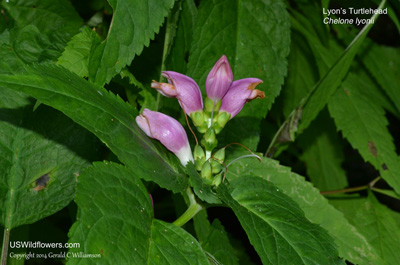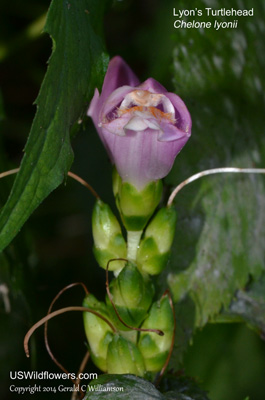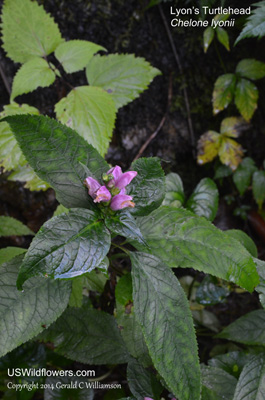Red Turtlehead, Pink Turtlehead, Lyon's Turtlehead, Appalachian Turtlehead - Chelone lyonii
|
Chelone lyonii - Red Turtlehead, Pink Turtlehead, Lyon's Turtlehead, Appalachian Turtlehead. Chelone was a woman of Greek Mythology who the gods changed into a turtle - perhaps with a head shaped similarly to the flowers on these plants. There are only four species in Chelone, all of them eastern North American natives. Two of them, C. glabra and C. obliqua, have fairly widespread native distribution, while C. cuthbertii and the species presented here, C. lyonii, have much more limited native distribution. The common names Red Turtlehead and Pink Turtlehead are applied to both C. lyonii and C. obliqua, and I would guess C. cuthbertii as well.
Chelone lyonii is probably native only to the higher Appalachian elevations of northeastern Alabama, eastern Tennessee, western North Carolina, and northwestern South Carolina. There are also reports of a likely native population on Lookout Mountain in northwestern Georgia. Other populations are likely naturalized from garden escapees.
Found in:
AL, CT, GA, MA, ME, MS, NC, NY, SC, TN, WV (Native in TN, AL, GA, NC, SC; naturalized in other states.)
Leave comments on Chelone lyonii at this link. | 
Distribution of Chelone lyonii in the United States and Canada:

Blue=Native; Grey=Introduced
Map from USDA Plants Database:
USDA, NRCS. 2017. The PLANTS Database (http://plants.usda.gov, 08 May 2025). National Plant Data Team, Greensboro, NC 27401-4901 USA.
Search Our Database: Enter any portion of the Scientific, Common Name, or both.
Do a general Google search of the entire site:
#ad
 Follow USWildflowers on Twitter
| | Site: Blue Ridge Parkway, Craggy Gardens Picnic Area, Buncombe County, NC Date: 2014-August-29 | Photographer: Gerald C. Williamson
Nikon D7000
Tamron SP 90MM f/2.8 AF Macro | | The pink flowers of Lyon's Turtlehead are fairly large, and are in a terminal raceme. The corolla is two-lipped, and resembles (to some, anyway) the head of a turtle. The lower flowers open first, and may be developing fruit while the distal flowers are still blooming. | | 
| | Site: Blue Ridge Parkway, Craggy Gardens Picnic Area, Buncombe County, NC Date: 2014-August-29 | Photographer: Gerald C Williamson
Nikon D7000 | | While some describe the corollas of Chelone lyonii as purple or reddish purple, they look pretty much pink to me - all Chelone except Chelone glabra have pink to reddish purple corollas; Chelone glabra has white corollas (sometimes with pinkish tints.) | | Click on the photo for a larger image

| | Site: Blue Ridge Parkway, Craggy Gardens Picnic Area, Buncombe County, NC Date: 2014-August-29 | Photographer: Gerald C Williamson
Nikon D7000 | | The lower lip of Chelone is bearded; C. lyonii has yellow or orangish-yellow hairs. The color of the tips of the single staminode per flower, not shown in these photos are they are interior to the corolla, is used to help identification where other characteristics don't make it obvious. C. lyonii staminodes tips are white to light pink. | | Click on the photo for a larger image

| | Site: Blue Ridge Parkway, Craggy Gardens Picnic Area, Buncombe County, NC Date: 2014-August-29 | Photographer: Gerald C Williamson
Nikon D7000 | | Lyon's Turtlehead is reported to grow up to about 6 feet tall, but is usually much shorter, in the 18 inch to 2 foot range. Chelone lyonii and Chelone obliqua are similar. C. obliqua has cuneate leaf bases (or perhaps, based on the species epithet, oblique, cuneate leaf bases.) C. lyonii has rounded or truncate leaf bases. The leaves of C. lyonii are widest closer to the base; those of C. obliqua are widest closer to the middle. A key characteristic are the petiole lengths. Those of C. obliqua are short, rarely more than about .6 of an inch long, while those of C. lyonii are longer up to about 2 inches long. C. cuthbertii leaves are sessile or on extremely short petioles; less than .25 inch. | | Click on the photo for a larger image

|
References used for identification and information:
|
|
| |
| #ad
|
|






